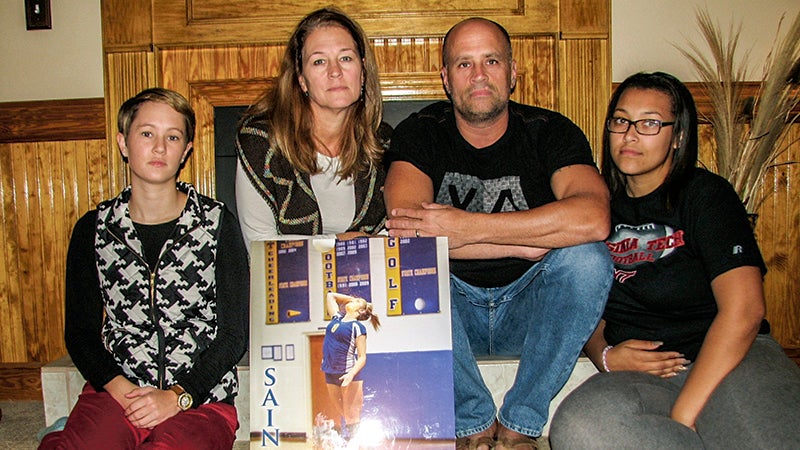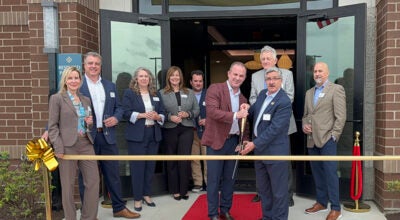Telling Tori’s story
Published 10:39 pm Tuesday, November 22, 2016

- The family and friends of Victoria Dail are left picking up the pieces after she died earlier this month from a suspected heroin overdose. Holding a photo of her playing Nansemond-Suffolk Academy volleyball in 2011 are, from left, her sister, Kelsey Honeycutt; her stepmother, Amy Dail; her father, Michael Dail; and her best friend, Jazmin Caldwell.
Victoria Dail was not the kind of person you would suspect of being addicted to heroin.
She was an athlete at Nansemond-Suffolk Academy and at Virginia Wesleyan College. She was a 2012 honor graduate at NSA. She was raised in a middle-class neighborhood. She was organized and well rounded. She was a good friend. She had a laugh described by her mother as “boisterous.” She was outgoing and always tried to make others around her feel comfortable. She had recently enlisted in the U.S. Navy and was looking forward to her basic training coming up in March.
“She was just an amazing girl that tried to do good in life,” said her father, Michael Dail.
But Tori, as her friends and family called her, fought her addiction silently until Nov. 10, when she died of what her family suspects was an accidental overdose.
Her family and friends don’t want the topic of addiction to be shushed, stigmatized or swept under the rug anymore.
“We shouldn’t be ashamed to say, ‘My sister is addicted to heroin,’” said Tori’s sister, Kelsey Honeycutt.
Michael Dail said it all started the summer after Tori graduated from high school, when she was in a bad car accident. She was prescribed pain pills and got addicted to them.
“It spiraled out of control,” he said.
On Dec. 3, 2014, he was cleaning up at their home in a neat subdivision off Manning Road. He found empty pill capsules in the trash in Tori’s room.
When he confronted her, she at first said they were just vitamins. But her father knew better, and he pressed her.
Finally, she admitted it. “’Dad, I have a problem,’” Dail recalls her saying.
Until then, Tori’s secret had been kept from even those closest to her.
“I never would have thought in a million years,” said her best friend from college, Jazmin Caldwell. “I wish she would have come to me. I don’t know if she felt like I would have judged her, but I would have helped her.”
“You just didn’t ever suspect it because of the caliber of student she was,” said her stepmother, Amy Dail.
Her family tried everything to help her get clean. Soon after he discovered the pills, Dail decided his daughter needed to get away from Virginia, so she went to live with her mother, Maureen Birmingham, in New York.
Birmingham was able to get Tori into a six-day detox program in New York.
“It took two days before we found a place our insurance would cover,” Birmingham said. “We called so many different places. They would only cover it for six days.”
Nevertheless, it seemed like Tori was on the road to recovery after that. She got a job, was helping her mother with her job as a business consultant, was attending Narcotics Anonymous meetings and was using suboxone, a drug commonly prescribed to help people addicted to opioids.
“She was on step 9 or 10,” Birmingham said of the 12-step NA program. “She was doing so good.”
But then, last month, Tori returned to Virginia to stay at her grandfather’s house in Greenbrier.
Family members held out hope that everything would be OK. Tori got a new job and was excited about her Navy enlistment. She had gotten into the career field she wanted and was looking forward to March 7, when she was to leave for basic training.
But on Nov. 10, Dail couldn’t get in touch with his daughter, so her grandfather went into her room to check on her. He found her slumped over and cold to the touch.
For Tori’s family, the silence was over. Her obituary told the world she lost her battle to addiction. It asked for donations in memory of Tori to be made to Facing Addiction Inc. A memorial service for Tori was held Nov. 14 at Suffolk Christian Church, and guests wore red ribbons, a symbol for awareness of drug addiction and prevention.
“I’m not scared to put her name out there and my name out there, because I think it needs to be said,” Michael Dail said. “People just need to know it’s OK to talk about it.”
Official action from the highest levels
There is more and more talk about opioid addiction these days, and it seems almost planned, coming right on the heels of Tori’s death.
Only three days after her funeral, the U.S. surgeon general issued a 428-page report titled “Facing Addiction in America.”
“For far too long, too many in our country have viewed addiction as a moral failing,” Dr. Vivek Murthy wrote in the report. “This unfortunate stigma has created an added burden of shame that has made people with substance use disorders less likely to come forward and seek help. We must help everyone see that addiction is not a character flaw — it is a chronic illness that we must approach with the same skill and compassion with which we approach heart disease, diabetes and cancer.”
Every day in the United States, 78 people die from an opioid overdose, according to the report. That statistic has nearly quadrupled since 1999. Only one in five people who need treatment for opioid use is receiving it.
Murthy made a number of recommendations in his report, ranging from education to health care policies to what communities, families and the private sector can do.
A week after Tori’s funeral, the Virginia Department of Health declared a public health emergency for opioid addiction and classified it as an epidemic.
“The consequences of opioid addiction in Virginia have risen to unprecedented levels and can now be classified as an epidemic,” Dr. Marissa Levine, state health commissioner, said at a Monday press conference this week. “We must treat it as a public health issue as we have for other health emergencies.”
Levine said three Virginians die of an opioid overdose every day, and about two dozen more are seen in emergency departments for non-fatal overdoses. In the first half of this year, fatal drug overdoses increased by a third statewide over last year.
To make matters worse, dealers have recently begun to mix heroin with frightening substances, such as carfentanil — a drug 10,000 times more potent than morphine, used in veterinary practice to immobilize large animals, such as elephants.
Levine said two confirmed cases of heroin mixed with carfentanil have been identified in Virginia — one in seized drugs and one in an overdose victim. One of them was in Hampton Roads.
“It gets to the point that if people are addicted and they’re injecting, they don’t know the potency of what they’re injecting,” Levine said.
Another action taken by state officials was to issue a statewide standing order for naloxone, authorizing any pharmacy to dispense it to anyone who asks for it. Naloxone can come in an auto-injector or a nasal spray and immediately counteracts the effects of opioids — both illicit and prescriptions — without causing any other effect on the body.
Caroline Juran, executive director of the state Board of Pharmacy, said many third-party insurers cover the cost, so just a copayment is necessary. People at risk of overdose and their family members can obtain the medication ahead of time to have on hand, Juran said.
“Those using prescription opioids medically for the treatment of chronic pain are also at risk of accidental overdose,” she said.
“You need to obtain the naloxone to have on hand just in case,” Levine said. “When we live in times of epidemic and emergencies, it’s important to take every opportunity to be prepared and informed.”
The extent of the local crisis
The Suffolk Police Department started to take notice of the opioid addiction crisis when it saw a spike in cases last year.
“I would say it’s definitely a crisis,” said Maj. Stephanie Burch, one of the department’s deputy chiefs. “It’s definitely a very serious issue.”
Through October of this year, there have been 21 opioid overdoses and two deaths in Suffolk, according to Lt. Jesse Epperson, the lieutenant for the special investigations section. Last year saw 28 overdoses and four deaths in the entire year.
Epperson said Suffolk’s numbers have declined since this July, although there’s no way to tell exactly why.
“We closed a number of significant cases,” he said. But the police realize that arrests are only one piece of the puzzle.
“I think awareness is part of it, too,” Burch said. “We’re not going to be able to arrest our way out of this issue.”
Epperson said the department has targeted suppliers and distributors while taking a more victim-based approach to users.
“The problem goes beyond Suffolk,” he said. “It’s a regional problem.” The department has an investigator assigned to a regional workgroup on combatting opioid abuse.
Recognizing that saving lives is key, the police department has sent two officers to be trained to train their colleagues in the administration of naloxone. Once officers are trained, Burch hopes every officer will be able to carry naloxone nasal spray in their vehicles to administer to suspected overdose victims. Her goal is to get that done before the end of December.
The Suffolk Department of Fire and Rescue already carries naloxone on ambulances and fire trucks, but a police officer is often closer to the scene of the call.
Burch said she believes the tide is changing on addiction, with everyone coming to the table to work on the issue and a shifting attitude in the community at large, viewing addiction as a disease rather than as a moral failure. And the toll on those left behind when an overdose death occurs is not to be forgotten.
“Every overdose death we respond to, there’s a family on the other end of this that has to suffer needlessly,” Burch said.
Help is available
Several types of treatment options are available locally through the Western Tidewater Community Services Board.
The community services board can offer detox on an outpatient basis, using a combination of medication, therapy and support groups, said Brandon Rodgers, administrator of program and service development for the community services board. It can also help link patients in need of more intensive recovery to residential treatment and office-based opiate treatment.
Its outpatient medically assisted detox program has been funded for the last six years through a grant from the Obici Healthcare Foundation, Rodgers said. “Without that, we wouldn’t have that program,” he added.
This April, Virginia’s Medicaid program will be expanded to cover short-term inpatient detox and residential treatments for Medicaid members, as well as increase rates for treatment services so that more providers are willing to offer them. When that takes effect, Rodgers said, the community services board likely will be able to begin offering office-based treatment.
But there are significant barriers to people seeking treatment. They have to want to seek help.
“Denial is a very serious thing,” Rodgers said.
People seeking treatment must also overcome a lack of education among their family and friends.
“Education of families and the public is important,” said Dr. Melissa Gross, medical director of the Western Tidewater Community Services Board. “I don’t know if it’s so much stigma as more educating families that this is a disease. You can’t just pull yourself up by your bootstraps. This is a disease. It’s chronic. There will be periods of relapse and periods of remission.”
It’s not just treating the physical symptoms of withdrawal, Rodgers said. Behavioral changes and treatment of mental health issues are also important.
“If you don’t change the relationships you have, the opportunity for relapse is pretty significant,” Rodgers said.
Finally, and perhaps most tragically, the highest risk of an overdose death comes after completing a detox program, Gross said, because a relapsed user will take the same amount they were taking before after having developed a tolerance to it.
“What we’ve learned specifically about opiate use is detox hasn’t been very helpful,” Gross said. “In medicine, we really don’t have all the answers. I think there’s still a lot we have to learn about this epidemic.”
Tori’s story
Time and time again, parts of Tori’s story come up when talking to experts in the field of opioid abuse.
She started abusing heroin after becoming addicted to pain pills that were legally prescribed to her. She had trouble accessing the help she needed but still tried a combination of techniques — residential detox, suboxone and even a support group.
But still, tragically, she died of an overdose after getting clean for a while.
Tori’s family and friends hope people out there will recognize Tori’s story and get help for themselves or a family member if needed — and, perhaps most importantly, implement educational programs to teach youngsters about the dangers of drug use.
“There is hope,” Michael Dail said. “There is recovery. People just need to know it’s OK to talk about it.”







